In the years I spent as a newspaper photographer, I was always jealous of reporters for one thing: they didn’t have to actually witness an event to report on it. They could interview people who had been there. Not so for photographers. If we missed it, we missed it. Re-creations weren’t permitted. That meant I always, always tried to arrive early. And I continue to do that, even with my landscape photography. Because I know that the early bird gets the light.
Two weeks ago my wife and I took a short driving vacation to Colorado. We rented a house near Rocky Mountain National Park, brought along our dogs and had a relaxing week. In addition to hikes every day, I had planned a couple of photo outings. One of those was an early-morning visit to Dream Lake.
Just over a mile’s walk in from the Bear Lake trailhead, it’s a relatively easy, though mostly uphill hike. During the day, that area is one of the most popular in the park, so the trail gets crowded and you usually need to take a shuttle just to get to the parking lot. Fortunately, for photos, that’s not the best time to be there. Sunrise is. And that changes everything.
Getting up at 5am, I arrived at the now almost empty parking lot by 5:45am. Since sunrise wasn’t until 7, I hiked the trail under headlamp, arriving at the lake around 6:15. Still dark, the sky was starting to show some illumination, so I decided to stop and do a little light painting of an area near the lake.
Light painting was something I hadn’t planned on that morning. However, one reason I’d bought that particular headlamp is because it has three modes: spotlight, floodlight and red light (all adjustable). The spotlight option, with my hands further constricting the beam, let me add some gentle illumination to areas in the foreground.
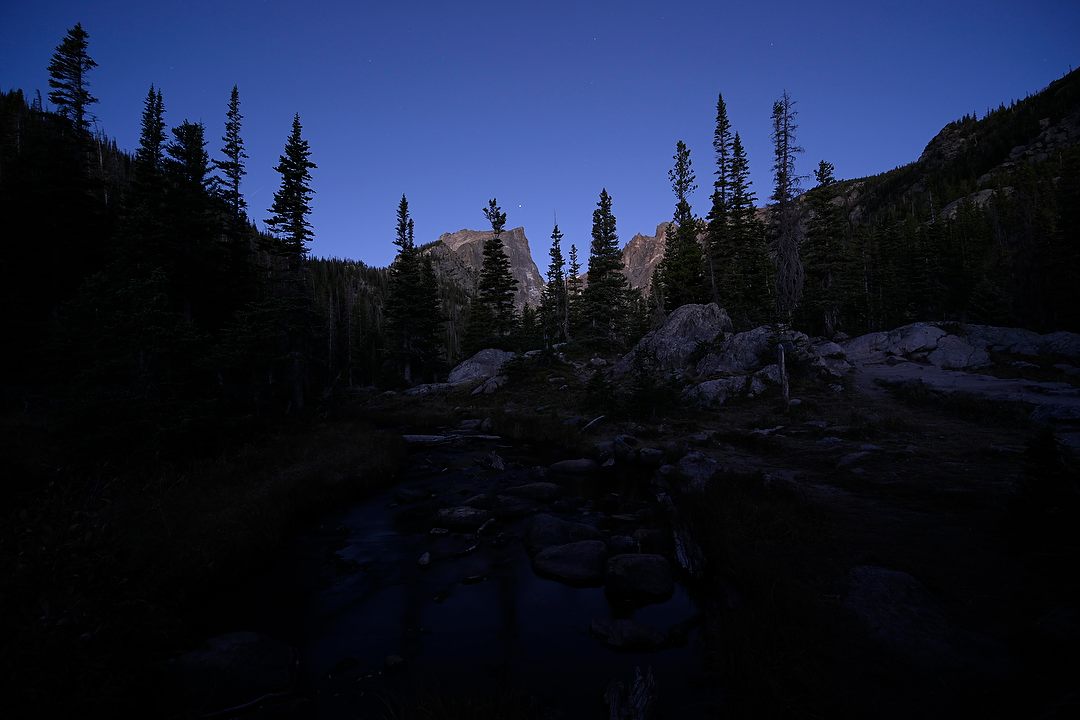
With Hallett Peak in the distance, this was the scene as I approached the lake early that morning. Nikon Z 7, Manual exposure, Sunny white balance, ISO 250, 8-seconds at f/5, Nikkor Z 14-30mm f/4 S lens at 15mm.
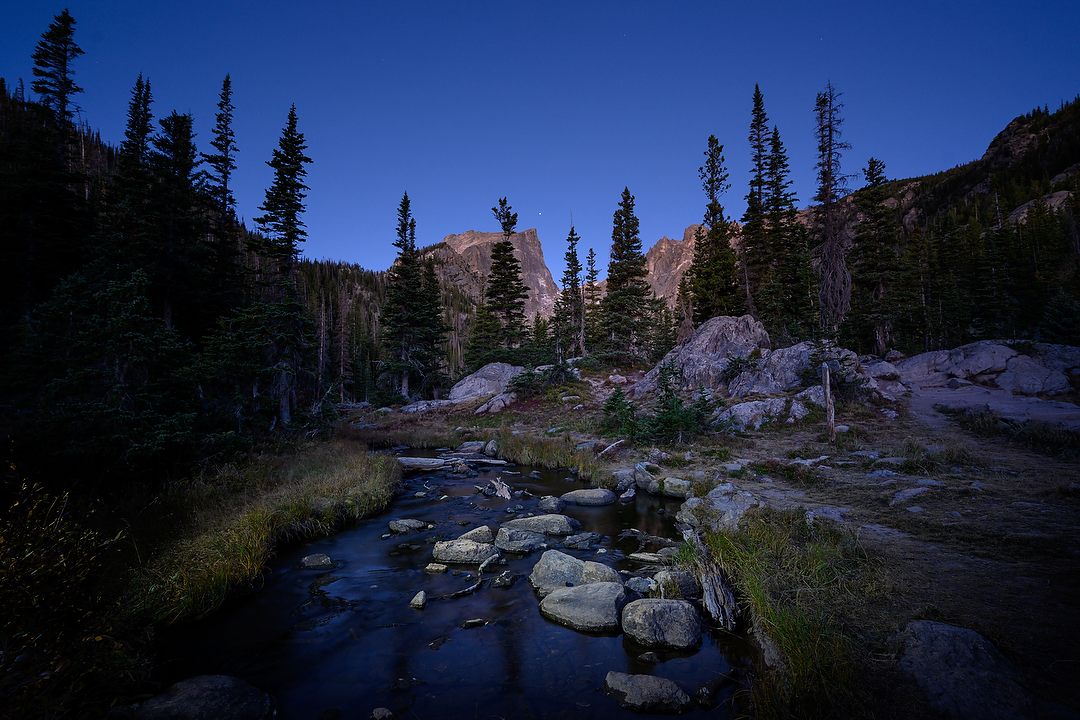
Setting the self-timer for ten seconds let me move off to far left, where I then used my Black Diamond headlamp to light the stream and rocks at this end of the lake. Nikon Z 7, Manual exposure, Sunny white balance, ISO 250, 6-seconds at f/6.3, Nikkor Z 14-30mm f/4 S lens at 16mm.
After that, it was time to find my spot along the lakeshore. Still thirty minutes before sunrise, there was a slight breeze rippling the lake’s surface and ruining any chance of a reflection. However, there was a small area choked by logs and rocks sheltered from the wind, which would offer that reflection. Setting up my tripod for a low angle, and cooling off from the climb to the lake, I put on my light down jacket, rested back against a tree and settled in to wait.
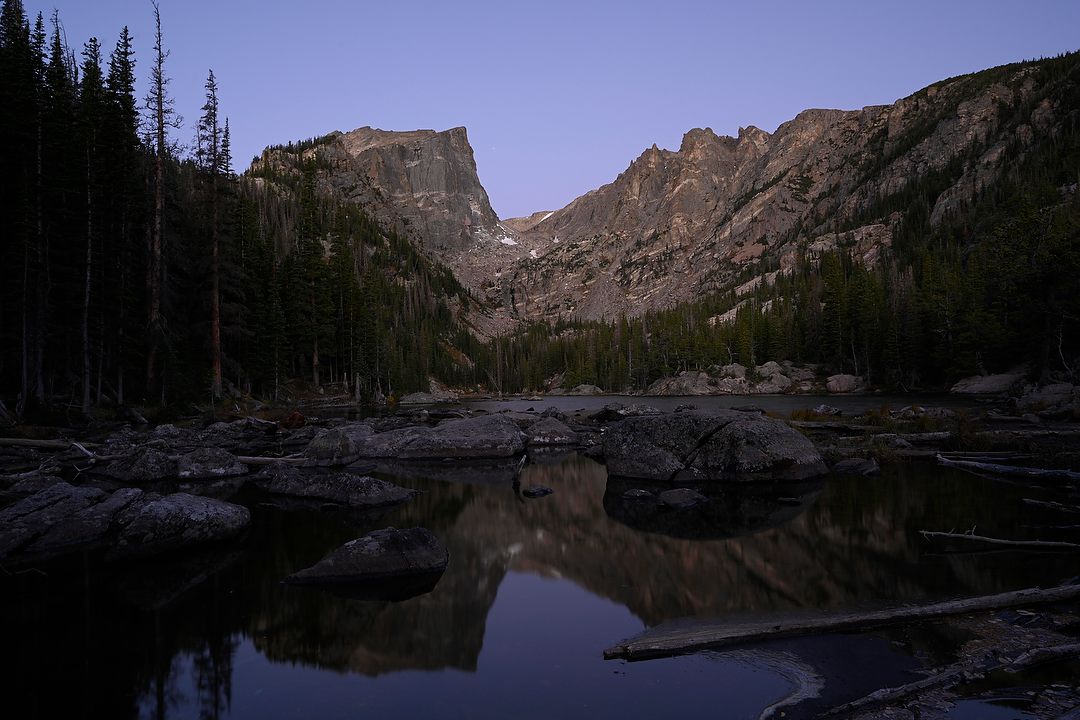
This is how the light, and scene, looked as I was setting up. Now I just needed to wait for the sun. Nikon Z 7, Manual exposure, Sunny white balance, ISO 200, 3-seconds at f/11, Nikkor Z 14-30mm f/4 S lens at 22mm.
As the rays of the rising sun began to strike the top of Hallett Peak, more and more photographers were arriving, and rushing to find a good angle and get their tripods set up. For me and the one other photographer who were there early, there was no rush at all. We were in the right place, ready to start our shoot. That also meant I had time to use my graduated neutral density filter to help shorten the range of light in the scene, letting me bring out more foreground detail and still hold the strong, rich light on the peak.
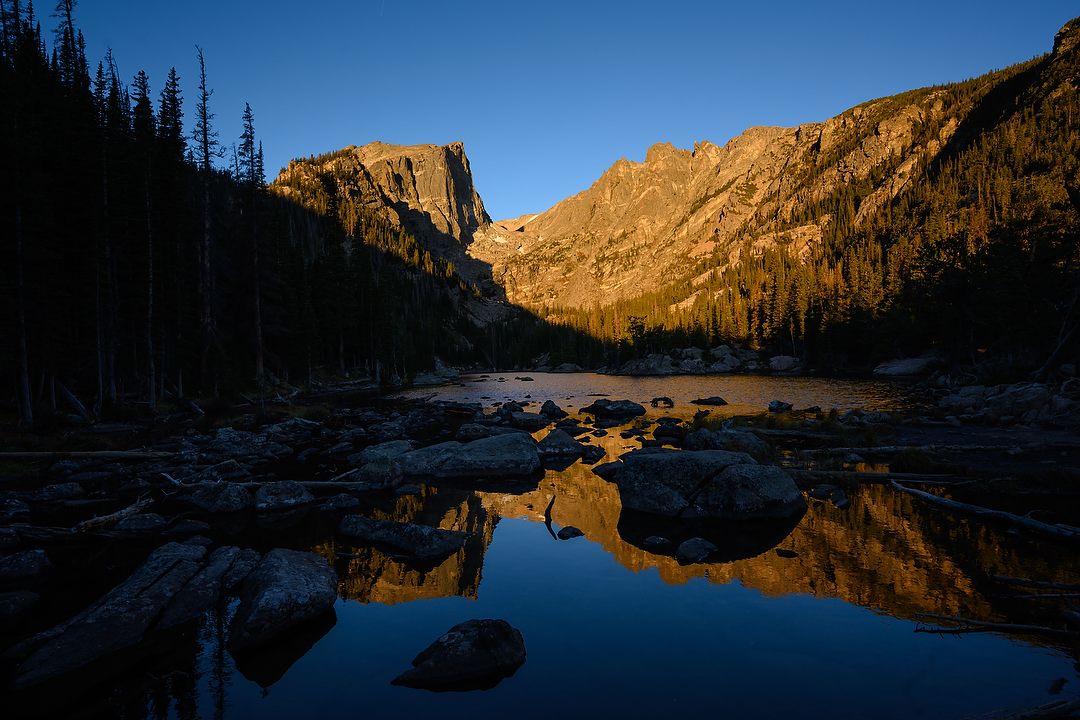
Here’s my final image from that sunrise at Dream Lake. You can see that I shifted position to make the logs in the right foreground less visible in the frame. I also used a 3-stop “soft” graduated neutral density filter to help even out the exposure between the sky and the reflection. Nikon Z 7, Aperture Priority, Sunny white balance, ISO 125, 1/100 at f/8 in Matrix metering, -1.7 EV, Nikkor NIKKOR Z 14-30mm f/4 S lens at 19mm.
Just thirty minutes after the first light appeared on the mountain, I was packing up. By then it had lost its warmth, and was no longer creating the dramatic, sculpted light on the peak and ridge to the right. And as I was leaving, more photographers were just arriving.
While I was done shooting the sunrise, I wasn’t done taking pictures. I did a fast hike in because it was dark and I wanted to have plenty of time to set up before the sun arrived. But now that it was already up, I planned to take full advantage of the walk out. Nothing quite compares to an easy downhill stroll with early-morning sun backlighting aspen in the fall.
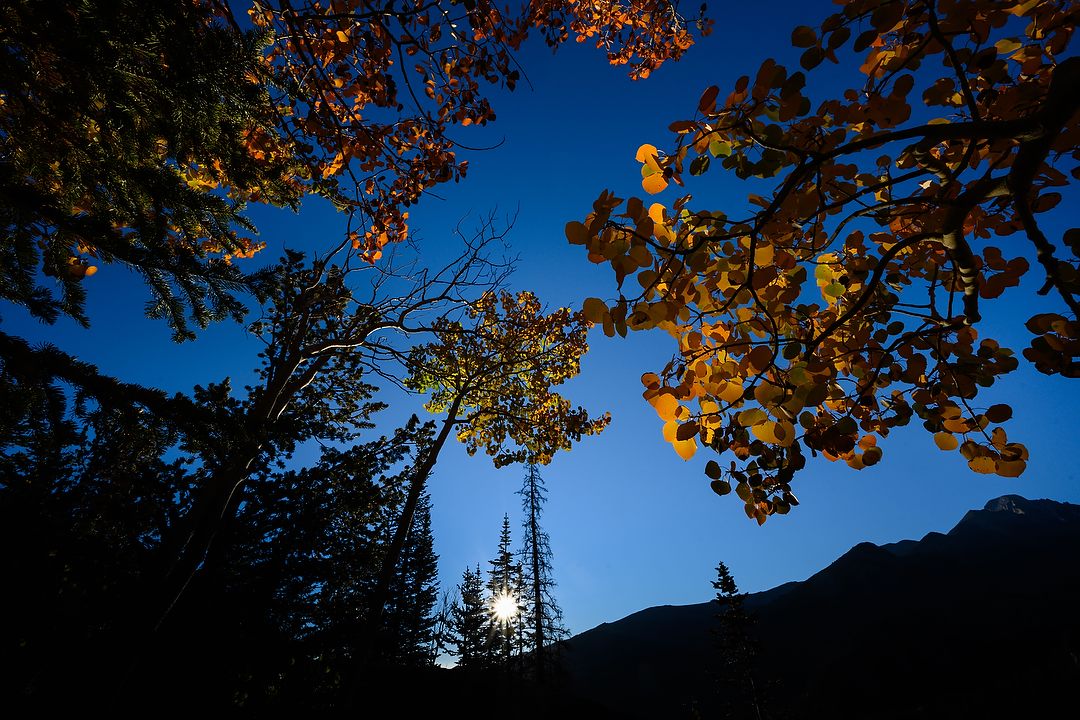
I made a number of stops on the hike out to photograph aspen showing off their fall colors. For this one I used a small aperture, and framed the sun partially blocked by a pine tree to get the sunburst effect. Nikon Z 7, Aperture Priority, Sunny white balance, ISO 200, 1/200 at f/16 in Matrix metering, -1.3 EV, Nikkor Z 14-30mm f/4 S lens at 14mm.
By 8:30 I was back at the cabin, joining my wife for breakfast. As I showed her what I’d photographed, I thought about those people who arrived just a few minutes too late for the best shots and wondered, “was that extra thirty minutes of sleep worth it?” In photography, being early is almost never a problem. But until we can turn back time, being late can be the difference between getting the picture or not. That’s why I’m an early bird.
Gear used:
Salomon lightweight backpack
Rain gear (in the mountains, you never know)
Lightweight down jacket
First-aid kit
Black Diamond ReVolt rechargeable headlamp
Think Tank Speed Demon waistbelt (no longer made, but other options available)
Nikon Z 7
Nikkor Z lenses, 14-30mm f/4, 24-200mm f/4-6.3
Peak Designs Travel Tripod
3-stop soft graduated neutral density filter
Polarizing filters
Spare camera battery
(If you like this story, please share it with your friends and let them know about the links on photography that I post on my business Facebook page. I’m also on Instagram and Twitter, @reedhoffmann. And if you’re curious about the workshops I teach, you can find them here. And, you can subscribe to this blog on my home page.)

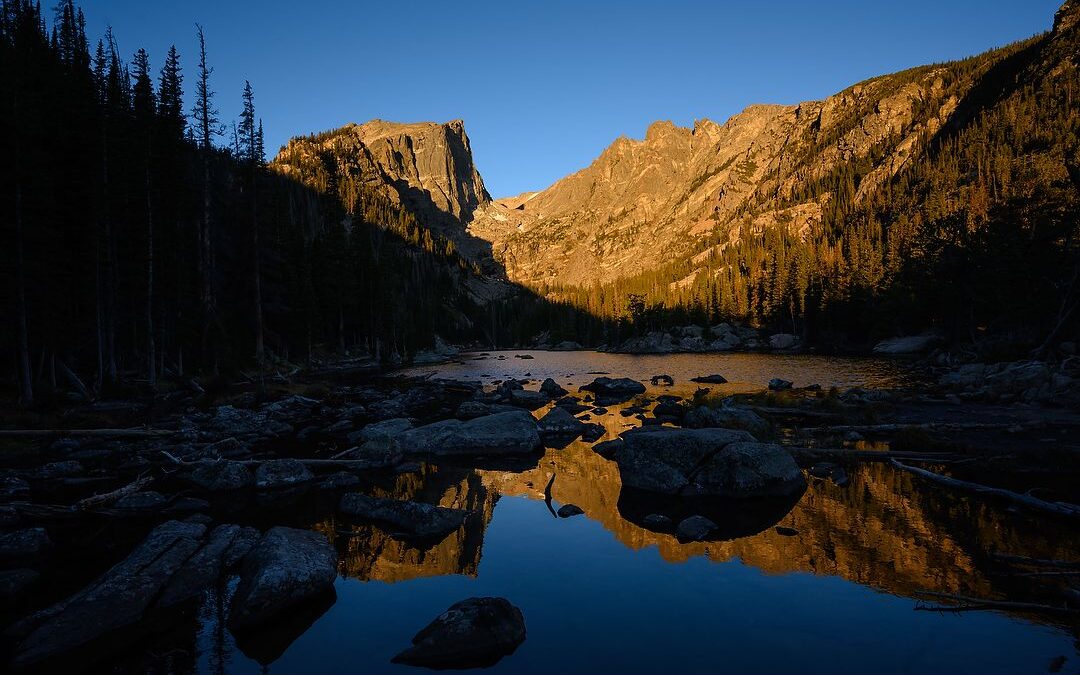
Reed, I’m not an early morning guy. So it’s painful to get up to shoot. But I’ve never regretted getting up when I see the result. Like you, I plan to meet my wife for breakfast. It works for both of us. Thanks for the reinforcement.
All so true re early arrival, pre-sunrise. I have to seriously work at this, because I’m not the early morning person I once was, thanks to working years of afternoon-evening newspaper shifts. But, once I get there, early, I’m glad I did.
The headlamp info is helpful, along with the photos that show with, without, and use of ND filter.
I’m sure breakfast was wonderful.
Hi Reed- beautiful shot- I would love to be able to drill into your mind a bit- and know why you did the settings you did- your “thinking”….. you starting out with manual settings and then using aperture priority- looking at your settings- it does not look like you used Auto ISO- and obviously with years of shooting- this all might just be second nature to you…… still- can you expand a bit on your thinking………. of course, I could always take one of your courses…. and I totally agree- I love early morning shooting on Lake Tahoe- when the light first hits from the east on the water and boats- while not exactly like yours- but the color and blue water is striking…. cheers from California
Hi John. When it’s truly dark, or even mostly dark, I just find it easier to use Manual exposure rather than trying to force Aperture (my preferred mode) to work. Once there’s enough light, I’ll go back to Aperture because I can work faster that way, and it helps me by adjusting to changing light conditions. As for ISO, I try to work with a low ISO when possible, to maximize quality. I like Auto ISO for “run-and-gun” situations, or when a fast shutter speed is more important than anything else. Hope to cross paths with you someday.
Thanks Reed, Great images,story & suggestions!